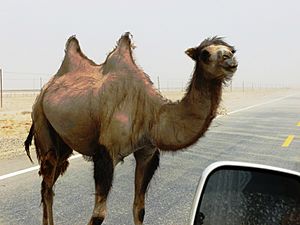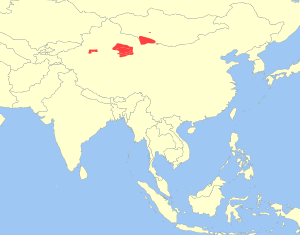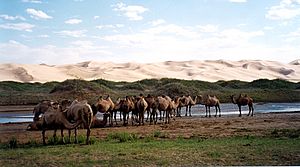Wild Bactrian camel facts for kids
Quick facts for kids Wild Bactrian Camel |
|
|---|---|
 |
|
| Wild Bactrian camel | |
| Conservation status | |
| Scientific classification | |
| Kingdom: | |
| Phylum: | |
| Class: | |
| Order: | |
| Family: | |
| Genus: | |
| Species: |
C. ferus
|
| Binomial name | |
| Camelus ferus Przewalski, 1878
|
|
 |
|
| Geographic range | |
The wild Bactrian camel (Camelus ferus) is a critically endangered species of camel living in parts of northern China and southern Mongolia. It is closely related to the Bactrian camel (Camelus bactrianus).
Both are large, double-humped even-toed ungulates native to the steppes of central Asia.
Until recently, wild Bactrian camels were thought to have descended from domesticated Bactrian camels that became feral after being released into the wild. However, genetic studies have established it as a separate species which diverged from the Bactrian camel about 1.1 million years ago.
Only about 1,000 camels still survive. Most live on the Lop Nur Wild Camel National Nature Reserve in China, and a smaller population lives in the Great Gobi A Strictly Protected Area in Mongolia. There are also populations in the Altun Shan Wild Camel Nature Reserve (1986) in Qakilik County, in the Aksai Annanba Nature Reserve (1992), and in Dunhuang Wanyaodun Nature Reserve (now Dunhuang Xihu Wild Camel Nature Reserve) contiguous with the reserve in Qakilik (2001) and a reserve in Mazongshan contiguous with the reserve in Mongolia, all in China.
Contents
Name
The two Bactrian species, C. bactrianus and C. ferus, are named after Bactria, a region in ancient central Asia.
Description
Wild Bactrian camels have long, narrow slit-like nostrils, a double row of long thick eyelashes, and ears with hairs to provide protection against desert sandstorms. They have tough undivided soles with two large toes that spread wide apart, and a horny layer which enables them to walk on rough and hot stony or sandy terrain. Their thick and shaggy body hair changes colour to light brown or beige during winter.
Like its close relative, the domesticated Bactrian camel, it is one of the few mammals able to eat snow to provide itself with liquids in the winter. While the legend that camels store water in their humps is a misconception, they are adapted to conserve water. However, long periods without water will result in a deterioration of the animal's health.
Differences from domestic Bactrian camels
There are several differences in size and shape between the two species. The wild Bactrian camel is slightly smaller than the domestic Bactrian camel and has been described as "lithe, and slender-legged, with very narrow feet and a body that looks laterally compressed."
The humps of the wild Bactrian camel are smaller, lower, and more conical in shape than those of the domestic Bactrian camel. These humps may often be about half the size of those of a domesticated Bactrian camel. T
he wild Bactrian camel has a flatter skull (havtagai, the Mongolian name for a wild Bactrian camel, means "flat-head") and a different shape of foot.
The wool of the wild Bactrian camel is always sandy coloured and shorter and sparser than that of domestic Bactrian camels.
The wild Bactrian camel can also survive on water saltier than seawater, something which probably no other mammal in the world, including the domestic Bactrian camel, can tolerate.
Behaviour
Wild Bactrian camels generally move in groups of up to 30 individuals, although 6 to 20 is more common depending on the amount of food available. They are fully migratory and widely scattered with a population density as low as 5 per 100 km. They travel with a single adult male in the lead and assemble near water points where larger groups can also be seen.
Their lifespan is about 40 years and they breed during winter with an overlap into the rainy season. Females produce offspring starting at age 5, and thereafter in a cycle of 2 years.
Distribution and habitat
Their habitat is in arid plains and hills where water sources are scarce and very little vegetation exists with shrubs as their main food source. These habitats have widely varying temperatures: the summer temperature ranges from 40–50 °C (104–122 °F) and winter temperature a low of −30 °C (−22 °F).
Wild Bactrian camels travel over long distances, seeking water in places close to mountains where springs are found, and hill slopes covered in snow provide some moisture in winter.
The size of a herd may vary up to 100 camels but generally of 2-15 members in a group; this is reported to be due to arid environment and heavy poaching.
The wild Bactrian camels are limited to three pockets in northwest China and some in southwest Mongolia. China spotted 39, and estimated that there were 600-650 camels in Altun Shan-Lop Nur reserves combined, in late 2018, with 48 spotted in Dunhuang reserve in 2018. At the Dunhuang and Mazongshan reserves, it had been estimated that one hundred camels exist per reserve, and for the Aksai reserve, it was estimated that there are nearly 200, according to an earlier estimation. In Mongolia, their population was about 800 in 2012.
In ancient times, wild Bactrian camels were seen from the great bend of the Yellow River extending west to the Inner Mongolian deserts and further to Northwest China and central Kazakhstan. In the 1800s, due to hunting for its meat and hide, its presence was noted in remote areas of the Taklamakan, Kumtag and Gobi deserts in China and Mongolia. In the 1920s, only remnant populations were recorded in Mongolia and China.
In 1964, China began testing nuclear weapons at Lop Nur, home to many of the wild Bactrian camels. The camels experienced no apparent ill effects from the radiation and continued to breed naturally. Instead, their habitat became a restricted military zone where human activity was kept to a minimum. After China signed the Comprehensive Test Ban Treaty in 1996, the camels were reclassified as an endangered species on the IUCN Red List.
Status
The wild Bactrian camel has been classified as Critically Endangered since 2002.
Threats
Wild Bactrian camels face many threats. The main threat is illegal hunting of the camels for their meat.
The only extant predators that regularly target wild Bactrian camels are gray wolves, which have been seen to pursue weaker and weather-battered camels. Due to increasingly dry conditions in the species' range, the numbers of cases of wolf predation on wild camels at oases has reportedly increased.
See also
 In Spanish: Camello bactriano salvaje para niños
In Spanish: Camello bactriano salvaje para niños



